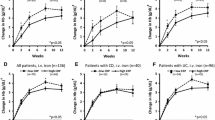Abstract
Background
Recent studies have suggested that a higher red blood cell distribution width (RDW) is associated with disease activity in patients with inflammatory bowel disease (IBD). However, the RDW in IBD patients without anemia has not been investigated.
Aim
This study aimed to determine whether or not RDW could be used for the assessment of disease activity in IBD patients with and without anemia.
Methods
The serum C-reactive protein (CRP) level, erythrocyte sedimentation rate (ESR), hemoglobin concentration, platelet and white blood cell counts, and RDW were assessed in 221 IBD patients, comprised of 120 patients with ulcerative colitis (UC) and 101 patients with Crohn’s disease (CD). Disease activity was determined for UC and CD with the Mayo score and the Crohn’s disease activity index, respectively.
Results
The CRP level, ESR, hemoglobin concentration, hematocrit, and RDW increased according to disease activity in patients with and without anemia (all P < 0.05). Multivariate analysis demonstrated that RDW was the best independent indicator for predicting disease activity in CD patients without anemia [odd ratios (OR), 1.702; 95% confidence interval (CI), 1.185–2.445; P = 0.004] and UC patients without anemia (OR, 4.921; 95% CI, 2.281–10.615; P < 0.001). Also, ROC curve analysis showed the RDW to be the most significant indicator of non-anemic active IBD [area under curve (AUC) in CD, 0.852, P < 0.001; AUC in UC, 0.827, P < 0.001].
Conclusion
The association between increased RDW and active IBD was evident in IBD patients with and without anemia.

Similar content being viewed by others
References
Podolsky DK. Inflammatory bowel disease. N Engl J Med. 2002;347:417–429. doi:10.1056/NEJMra020831.
Vermeire S, Van Assche G, Rutgeerts P. Laboratory markers in IBD: useful, magic, or unnecessary toys? Gut. 2006;55:426–431. doi:10.1136/gut.2005.069476.
Rudolph WG, Uthoff SM, McAuliffe TL, Goode ET, Petras RE, Galandiuk S. Indeterminate colitis: the real story. Dis Colon Rectum. 2002;45:1528–1534. doi:10.1097/01.DCR.0000034051.08192.A2.
Abdelrazeq AS, Wilson TR, Leitch DL, Lund JN, Leveson SH. Ileitis in ulcerative colitis: is it a backwash? Dis Colon Rectum. 2005;48:2038–2046. doi:10.1007/s10350-005-0160-3.
Karnad A, Poskitt TR. The automated complete blood cell count. Use of the red blood cell volume distribution width and mean platelet volume in evaluating anemia and thrombocytopenia. Arch Intern Med. 1985;145:1270–1272.
Hammarsten O, Jacobsson S, Fu M. Red cell distribution width in chronic heart failure: a new independent marker for prognosis? Eur J Heart Fail. 2010;12:213–214. doi:10.1093/eurjhf/hfp208.
Anderson JL, Ronnow BS, Horne BD, et al. Usefulness of a complete blood count-derived risk score to predict incident mortality in patients with suspected cardiovascular disease. Am J Cardiol. 2007;99:169–174. doi:10.1016/j.amjcard.2006.08.015.
Ani C, Ovbiagele B. Elevated red blood cell distribution width predicts mortality in persons with known stroke. J Neurol Sci. 2009;277:103–108. doi:10.1016/j.jns.2008.10.024.
Brusco G, Di Stefano M, Corazza GR. Increased red cell distribution width and coeliac disease. Dig Liver Dis. 2000;32:128–130. doi:S1590-8658(00)80399-0.
Cakal B, Akoz AG, Ustundag Y, Yalinkilic M, Ulker A, Ankarali H. Red cell distribution width for assessment of activity of inflammatory bowel disease. Dig Dis Sci. 2009;54:842–847. doi:10.1007/s10620-008-0436-2.
Clarke K, Sagunarthy R, Kansal S. RDW as an additional marker in inflammatory bowel disease/undifferentiated colitis. Dig Dis Sci. 2008;53:2521–2523. doi:10.1007/s10620-007-0176-8.
Stange EF, Travis SP, Vermeire S, et al. European evidence-based Consensus on the diagnosis and management of ulcerative colitis: Definitions and diagnosis. J Crohns Colitis. 2008;2:1–23. doi:10.1016/j.crohns.2007.11.001.
Stange EF, Travis SP, Vermeire S, et al. European evidence based consensus on the diagnosis and management of Crohn’s disease: definitions and diagnosis. Gut. 2006;55:i1–i15. doi:10.1136/gut.2005.081950a.
Schroeder KW, Tremaine WJ, Ilstrup DM. Coated oral 5-aminosalicylic acid therapy for mildly to moderately active ulcerative colitis. A randomized study. N Engl J Med. 1987;317:1625–1629. doi:10.1056/NEJM198712243172603.
D’Haens G, Sandborn WJ, Feagan BG, et al. A review of activity indices and efficacy end points for clinical trials of medical therapy in adults with ulcerative colitis. Gastroenterology. 2007;132:763–786. doi:10.1053/j.gastro.2006.12.038.
Felker GM, Allen LA, Pocock SJ, et al. Red cell distribution width as a novel prognostic marker in heart failure: data from the CHARM Program and the Duke Databank. J Am Coll Cardiol. 2007;50:40–47. doi:10.1016/j.jacc.2007.02.067.
Tonelli M, Sacks F, Arnold M, Moye L, Davis B, Pfeffer M. Relation between red blood cell distribution width and cardiovascular event rate in people with coronary disease. Circulation. 2008;117:163–168. doi:10.1161/CIRCULATIONAHA.107.727545.
Weiss G, Goodnough LT. Anemia of chronic disease. N Engl J Med. 2005;352:1011–1023. doi:10.1056/NEJMra041809.
Papadaki HA, Kritikos HD, Valatas V, Boumpas DT, Eliopoulos GD. Anemia of chronic disease in rheumatoid arthritis is associated with increased apoptosis of bone marrow erythroid cells: improvement following anti-tumor necrosis factor-alpha antibody therapy. Blood. 2002;100:474–482. doi:10.1182/blood-2002-01-0136.
Forhecz Z, Gombos T, Borgulya G, Pozsonyi Z, Prohaszka Z, Janoskuti L. Red cell distribution width in heart failure: prediction of clinical events and relationship with markers of ineffective erythropoiesis, inflammation, renal function, and nutritional state. Am Heart J. 2009;158:659–666. doi:10.1016/j.ahj.2009.07.024.
Lippi G, Targher G, Montagnana M, Salvagno GL, Zoppini G, Guidi GC. Relation between red blood cell distribution width and inflammatory biomarkers in a large cohort of unselected outpatients. Arch Pathol Lab Med. 2009;133:628–632. doi:10.1043/1543-2165-133.4.628.
Acknowledgment
This paper was supported by Songcheon Research Fund, Sungkyunkwan University, 2011.
Author information
Authors and Affiliations
Corresponding author
Rights and permissions
About this article
Cite this article
Song, C.S., Park, D.I., Yoon, M.Y. et al. Association Between Red Cell Distribution Width and Disease Activity in Patients with Inflammatory Bowel Disease. Dig Dis Sci 57, 1033–1038 (2012). https://doi.org/10.1007/s10620-011-1978-2
Received:
Accepted:
Published:
Issue Date:
DOI: https://doi.org/10.1007/s10620-011-1978-2




